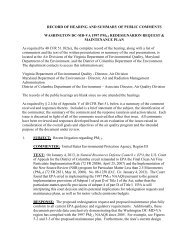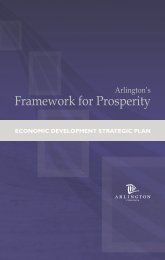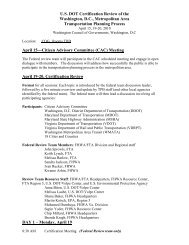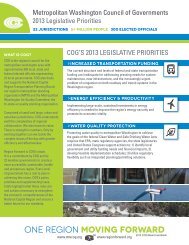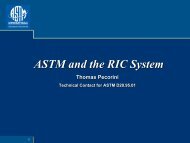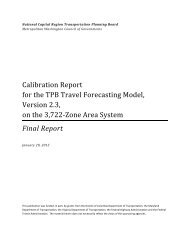PTI Local Government Energy Assurance Guidelines - Metropolitan ...
PTI Local Government Energy Assurance Guidelines - Metropolitan ...
PTI Local Government Energy Assurance Guidelines - Metropolitan ...
You also want an ePaper? Increase the reach of your titles
YUMPU automatically turns print PDFs into web optimized ePapers that Google loves.
2.4 Understanding Continuity of Operations Plans<br />
It is important that planners review available Continuity of Operations Plans (COOPs) in their local governments,<br />
regions and/or States. As part of the energy assurance planning process, local governments should consider<br />
developing and/or updating contingency COOPs for vital government functions in light of energy assurance issues.<br />
Such vital functions include providing backup power generation to life-sustaining equipment, as well as access to<br />
fuel and short-term shelter, among other things.<br />
The COOP details how to deliver minimum essential functions throughout an energy emergency. It will usually list<br />
specific actions taken to mitigate an energy emergency. Most COOPs will list essential services, key staff responsible<br />
for those services, technology priorities (especially communications, a top priority for all government COOPs),<br />
security and access protocols, and related issues.<br />
Every COOP is different, as it is designed to meet specific local needs. Generally, the prime objectives for<br />
government COOPs include:<br />
■■<br />
■■<br />
■■<br />
■■<br />
■■<br />
■■<br />
Ensuring the continuous performance of government’s essential operations during a disaster<br />
Reducing loss of life and minimizing damage to property<br />
Achieving a timely and orderly recovery from a disaster<br />
Protecting key assets, including facilities, from damage<br />
Mitigating disruptions to operations<br />
Ensuring minimal loss of energy and electricity to key assets<br />
Major energy intensive industries also will usually have formal COOPs in place. It is helpful to solicit input from<br />
these industries and other local businesses that have developed their own COOPs. Lessons learned from private<br />
sector plans can help with developing or enhancing a local EAP.<br />
Key Questions<br />
…in understanding COOP Plans<br />
1. Does the local jurisdiction have a Continuity of Operations Plan (COOP) in place?<br />
2. How does the local EAP interact with the COOP, and what have planners done to ensure that<br />
the plans are consistent?<br />
3. When was the last time the local COOP was updated, and why?<br />
4. Which private sector partners may have a COOP in place that local planners might learn from,<br />
and are these partners likely to share some of this information?<br />
5. Have planners considered incorporating successful components of private sector COOPs into<br />
the government COOP?<br />
6. Does the local COOP list all known quantities of fuel, fuel supplier contact information, backup<br />
power supplies, and the fuels used for all of the backup power supplies?<br />
<strong>Local</strong> <strong>Government</strong> <strong>Energy</strong> <strong>Assurance</strong> <strong>Guidelines</strong> – Version 2.0 | 11



